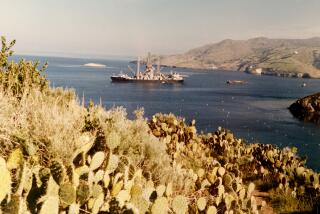Dan Taylor Jr., 65; Built Submarines to Search for Loch Ness Monster
- Share via
Dan Scott Taylor Jr., who dreamed of finding the elusive Loch Ness Monster and built his own submarines for the search, has died. He was 65.
Taylor died July 23 in a Savannah, Ga., hospital of complications after surgery to correct an aortic aneurysm. He lived in Bluffton, S.C.
Taylor had recently been working on Nessa, a 44-foot submarine designed for his second excursion into Loch Ness, the 700-foot-deep glacially carved Scottish lake purported to be the home of a giant serpent.
Despite numerous scientific studies debunking the tale, Taylor firmly believed that the monster -- or monsters -- was there. For one thing, he thought one of them said hello to him in 1969.
Intrigued with the legendary Loch Ness Monster since childhood, Taylor talked his way into assisting University of Chicago biologist Roy P. Mackal on a hunt of the lake sponsored by the World Book Encyclopedia.
Taylor volunteered his Viperfish, a 20-foot fiberglass submarine he had built in his spare time.
Piloting it on one of his last runs, he suddenly felt the Viperfish mysteriously turn and yaw. Looking out, he saw what he described as a big dust cloud.
“It wasn’t until I was back on the surface and on dry land,” he told Scotland on Sunday newspaper in 2000, “that it occurred to me that this might have been the monster saying hello.”
Whatever he saw sped away before Taylor could catch it with his seven-horsepower submarine, which had a maximum speed of 8 mph.
During the six-month expedition, his Viperfish leaked repeatedly, and its weak lights were unable to cut through the murky, peat-silted water.
Taylor became convinced that he needed a bigger, faster submarine to prove the existence of the so-called monster that has been dubbed Nessie. He determined to build one -- a plan he couldn’t carry out until he retired from running his late mother’s restaurants.
The former Navy submariner stepped up his efforts after a heart attack and stroke in 1995 cost him the sight in one eye and hearing in one ear. After selling his house, he and his retired schoolteacher wife, Margaret, moved to his mother’s property in Hilton Head, S.C.
“When you sit around thinking and dreaming of something for 30 years, it’s time to fish or cut bait,” he told The Times in 1998 when he was already working on the submarine in a Hardeeville, S.C., warehouse. “This is the challenge of my life. Gosh, what else could I do? What else should I do? This is just something that’s stuck in my craw.”
He equipped the vessel with powerful lights, side-scanning sonar and harpoon “biopsy wands,” or devices designed to grab a piece of the monster’s flesh. Taylor also planned to install video and infrared cameras to verify encounters with the monster.
“I don’t have any plan to capture Nessie,” he told Scotland’s Sunday Herald newspaper in 2000. “I just want to take a sample of her skin, so we can finally uncover the truth about whether she is a mammal, a fish or a dinosaur.”
Taylor, who believed Nessie was a giant eel, named the new exploratory vessel Nessa, for the Celtic goddess of water.
With a battery-powered 500-horsepower engine from a locomotive, he said the new submarine could travel 23 mph. He worked on the vessel eight hours a day, seven days a week without a blueprint, keeping the plans in his head.
“An artist wouldn’t make a blueprint,” he told The Times in 1998. “It’s like a painter can see a painting before he starts -- I can see this boat in my mind.”
Better able to attract the news media than major investors, Taylor discussed his project on network television, in People and other magazines, and in newspapers including The Times and the Atlanta Journal-Constitution.
He financed the construction himself, using money from the sale of his house and his inheritance.
Like the Nessa, the Viperfish had been yellow, and some ‘60s-era news media playfully speculated that the Beatles, because of their hit “The Yellow Submarine,” might come to watch Taylor’s first search.
Taylor said the color was for safety and no joking matter.
“It’s the last color of the spectrum to be visible under water and is the easiest to see when you are deep in the depths,” he told Scotland on Sunday.
The Viperfish later sat as a novelty advertisement outside his mother’s Aquarium restaurant in Memphis, which he operated with his wife.
Born in that Tennessee city, Taylor had been fascinated by inventing and the water from an early age.
At 7, he attached empty oil cans to his bike, thinking they would act as pontoons, and confidently rode the bike into a lake. It sank.
“I learned a lot about ballast that day,” he told The Times.
At 10, he built his first submersible from an old wine barrel, with a trapdoor for access and a glass panel at the end. He climbed aboard and launched it into his parents’ fish pond. Like the bike-boat, the would-be sub promptly sank.
“It was just as well the water was only 4 feet deep,” he said years later.
Taylor volunteered for the Navy when he was 18 and became a torpedo man on submarines, participating in the U.S. blockade of Cuba in 1962.
He studied submarine design at the Georgia Institute of Technology and later worked with companies building mini-submarines.
In the mid-1960s, he piloted a submersible searching the Mediterranean for a hydrogen bomb lost when a B-52 aircraft went down.
Over the years, he built a 90-foot windmill to generate electricity and a 4,000-gallon aquarium, tinkered with a remote-controlled torpedo and tried unsuccessfully to refurbish a hydroelectric dam.
“Nothing I make ever works the first time,” he cheerfully told The Times.
Taylor is survived by his wife, Margaret Wade Taylor, and two sisters, Janet Smith and Tina Taylor of Memphis.
More to Read
Sign up for Essential California
The most important California stories and recommendations in your inbox every morning.
You may occasionally receive promotional content from the Los Angeles Times.










